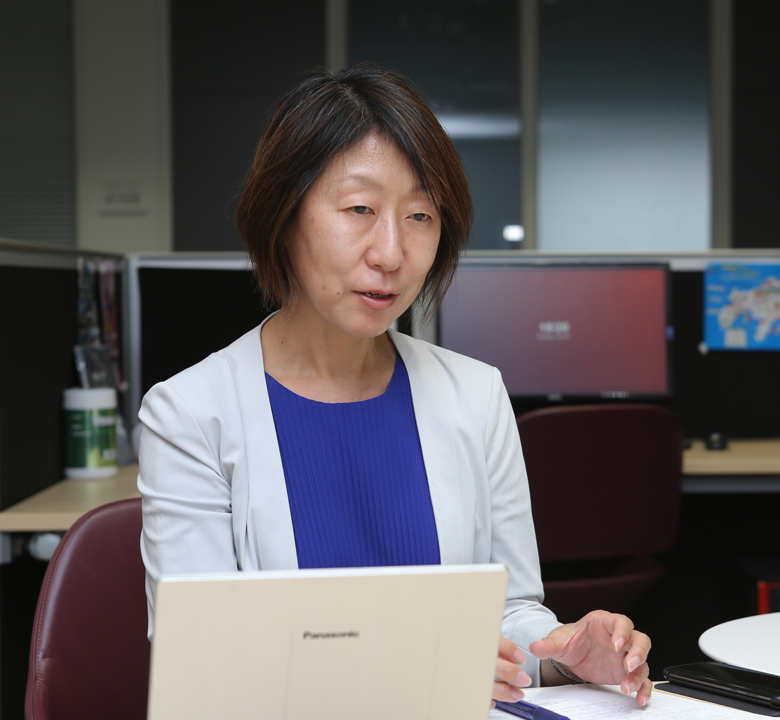 |
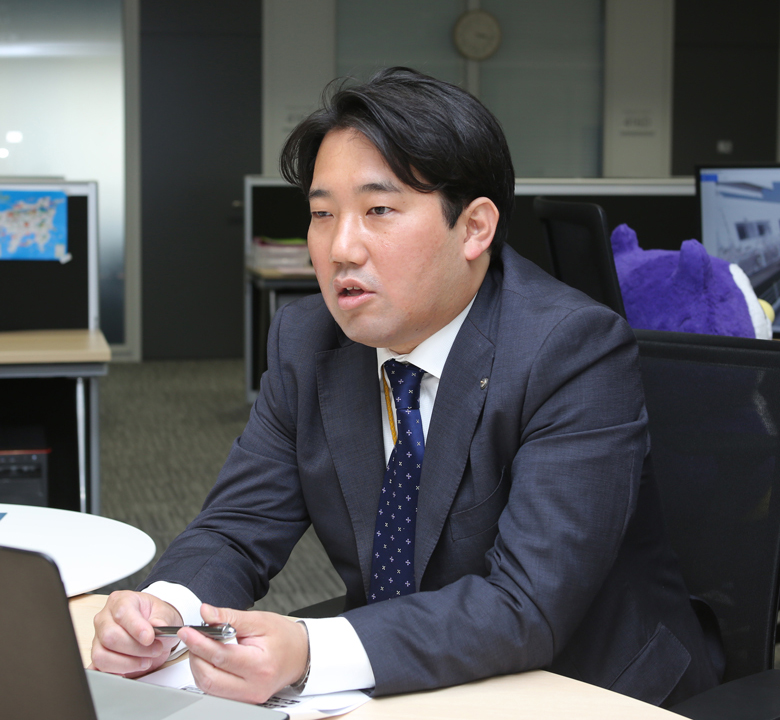 |

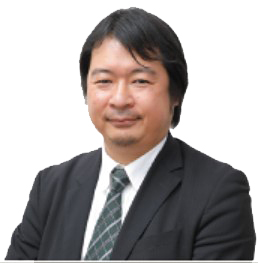 |
| Professor Mariko Nakabayashi, Meiji Institute of Autonomous Driving (MIAD) |
Mr. Naoyoshi Yoshida, Lawyer and Visiting Researcher of Meiji Institute of Autonomous Driving (MIAD) |
Professor Takahiro Suzuki, New Industry Creation Hatchery Center (NICHe), Tohoku University. |
MIAD and Approaches Centered on Legal and Insurance Fields
Meiji University was founded in 1881 as Meiji Law School. Since then, it boasts of its history of 140 years. The University is currently organized by 10 undergraduate schools of Law, Commerce, Political Science and Economics, Arts and Letters, Science and Technology, Agriculture, Business Administration, Information and Communication, Global Japanese Studies, and Interdisciplinary Mathematical Sciences; 12 graduate schools, and four professional graduate schools and so on. The number of students in total of under-graduate and graduate schools exceeds 34,000, for whom the Univ. employs about 1090 full-time faculty members, having four campuses at Surugadai, Izumi, Ikuta, and Nakano.
It was 2018 that "Meiji Institute of Autonomous Driving (MIAD)" was established within the Surugadai Campus of Meiji Univ. As autonomous driving technologies were attracting attention, 4 divisions were installed: 1) Law, 2) Insurance, 3) Technologies, and 4) Regional revitalization, so that researchers within the Univ. with different specialties could be organically united to make efforts based on the assumption that there would be a wide range of problems in its social implementation. It was designed to become the basis of not only technical development of autonomous driving but also interdisciplinary research such as legal and insurance issues, designing regional society, and environmental development surrounding road traffic. According to Professor Nakabayashi, Head of the insurance division, an idea was reflected in the planning like this: "Though insurance and law divisions belong to the humanities fields, studying together with people in the technical divisions will bring about effective efforts to create better society using autonomous driving technologies." This allowed the institute to establish the system capable of acting in cooperation not only within the University but also with external research institutes in a flexible way. For example, in Fukushima, research with focus on the fields of law and insurance is proceeded, and in other places such as Tsushima-shi, Nagasaki pref., demonstration experiments are going on towards social implementation of autonomous driving technologies.
In addition, Lawyer Yoshida, Visiting Researcher, had started research on autonomous driving as well as social environment surrounding autonomous driving with Japan Electronics and Information Technology Industries Association (JEITA) and others before MIAD was established. He has also been acting as a visiting researcher of Law division and Chairman of Social Implementation Committee since three years ago when MIAD was established. He is engaged in this cooperative activity with Tohoku University as the main player.
Legal and Insurance Divisions of MIAD Linked with Engineering Approach of Tohoku University
MIAD set the theme of joint research as "reproduction by way of simulation of the vehicle behavior" with Prof. Suzuki. To realize this, it is necessary to create the real site as a DS scenario. For this task, they paid attention to the three-dimensional (3D) map data for autonomous driving. Their opinions agreed with each other that combining 3D map data so that they can be used both for autonomous driving and DS would gain greater synergistic effect. Then they started creating 3D map data for the Hama-dori area of Fukushima Prefecture. Especially, DS was considered an important tool for research and development capable of conducting virtual experiments realistically by reproducing unusual situations. Therefore, it was assumed to be used as a platform for utilizing data.
Fukushima Hama-dori is an area where traffic was cut off due to the Great East Japan Earthquake and so efforts for restoration have been kept on from various angles. Prof. Suzuki has been studying town planning that integrates next-generation mobility such as autonomous driving and electric vehicles as well as the near-future technologies including robots, through a national project (The Fukushima Innovation Coast Framework) that encourages universities etc. to guide and accumulate "knowledge" that contributes to restoration of Fukushima (knowledge about restoration) within Hama-dori Area.
MIAD and Prof. Suzuki started to create 3D map data for the Hama-dori area of Fukushima Prefecture under this Fukushima Innovation Coast Framework. In this process, according to him, he began collaborating with the activities of MIAD this time under the cooperation of Associate Professor Shigeyuki Yamabe, NICHe (New Industry Creation Hatchery Center) of Tohoku University, of whom Prof. Suzuki speaks as "the leading expert in the nation as to the research on the engineering fields using DS".
MIAD and Prof. Suzuki have an idea like this: in aiming at both realizing next-generation traffic and solving problems for reconstruction in the concerned area, combining the regional characteristics of the Fukushima Hama-dori area where robot technologies are accumulated due to the Fukushima Innovation Coast Framework can make it possible, for example, "to promote next-generation town planning at a stretch, if the place where the Tsunami had changed the infrastructure environment can be developed as a platform for digital map environment". What's more, they hope it can be "a proposal as a local DX (digital transformation)".
Adoption of UC-win/Road DS and Diverse Research Using DS
Ahead of these efforts, first of all, Visiting Researcher Yoshida reviewed some DS products in MIAD with advice from Associate Prof. Yamabe and others. UC-win/Road DS was adopted from its comprehensive evaluation including its functions as a single component of DS such as operability and visual aspects, that there were application cases of 3D map data to be gained for autonomous driving to the civil engineering field, and that FORUM8 was positive towards new research and development. It was also a decisive factor that it has a high affinity so that MIAD can use point cloud data it gains for editing and creating scenarios with UC-win/Road DS.
On the other hand, Tohoku University has been owning and using DS made by other company for many years. However, the Univ. had already developed a system to share scenarios between its existing DS and UC-win/Road DS. Therefore, adding FORUM8's DS introduced by MIAD will allow effective use of both DS's, according to Prof. Suzuki.
After adopting DS, MIAD is planning the following research themes to work on in collaboration with external organizations such as Tohoku University, The University of Tokyo, Okayama University, Center for Research on Adoption of NextGen Transportation Systems of Gunma University, as well as JEITA and private companies:
1) Examination of methods to reproduce the real-vehicle behaviors from the data gained from real automobiles,
2) Examination of standards of recorders such as the Data Storage System for Automated Driving vehicles to be mounted on an autonomous car,
3) Examination of how to analyze traffic accidents using real vehicle data,
4) simulating the surrounding environment of automobiles using DS for consensus building among traffic participants such as automobiles and pedestrians. And examination of a new form of laws and regulations using it,
5) Establishment of a dispute settlement method about autonomous vehicles,
6) Digitization of the road management ledgers and automation of road management,
7) Examination of a regional revitalization method by creating VR and three-dimensional media of the surrounding environment.
Under such circumstances, in the last fiscal year, MIAD and Prof. Suzuki, Tohoku Univ. jointly collected 3D map data for scenario data to be mounted on DS. To do so, they had MMS, the mobile mapping system for gaining 3D point cloud data around the road on which the vehicle mounted with measuring equipment travels, travel in the Fukushima Hama-dori area (MIAD took charge of Futaba-cho and Tohoku Univ. Namie-cho and Minamisoma-city) with cooperation of Professor Satoshi Nishiyama, Graduate School of Environmental and Life Science, Okayama University and Kokusai Kogyo Co., Ltd. In Futaba-cho, the road environment including not only the part above the ground but also underground buried objects were converted into data as much as possible, and taken in to DS adopted this time. Prof. Suzuki says, "we hope to increase smoothness and effectiveness in the part of scenario creation especially, which is a bottle neck of the DS" through their efforts in the future.
In this fiscal year, with cooperation of Prof. Suzuki, Tohoku Univ., MIAD is planning to equip the route bus traveling in the area of which the 3D map was created in the previous fiscal year with measuring equipment, collect data quantitatively and regularly, take in the data into the DS, and utilize the data for individual research themes. In specific, their plan includes the following items to study:
1) Inputting the data assuming those to be stored in EDR (event data recorder) or DSSAD (Data Storage System for Automated Driving vehicles) equipped with the automobile, and reproducing the real-car behaviors;
2) Narrowing the recording items for the planned standards of DSSAD to be equipped with the autonomous car they have been working on with JEITA, based on the degree of contribution to the reproducibility of respective data;
3) The method of analyzing traffic accidents using real-car data in the research and development program "Promotion of R&D that addresses ethical, legal and social implications/issues (ELSI) in S&T comprehensively and practically" applied jointly by Institute of Industrial Science, The University of Tokyo, University of Tsukuba, and MIAD;
4) Anonymization of privacy information contained in the data to promote data linkage among universities studying autonomous driving with MIAD and Tohoku Univ as the core, along with the linkage methods
5) Analysis of road situations and driving behaviors of automobiles using AI and simulation in order to establish an effective communication method between human beings and vehicles (HMI: human machine interface);
6) Systems of solving dispute on autonomous cars including insurance based on the knowledge acquired through research;
7) Automation of road management utilizing data about vehicles collected quantitatively and regularly and that of LiDAR;
8) Contribution to the local reconstruction and regional revitalization by creating a 3D map of Fukushima Hama-dori area and its VR and informing the present situation of the area where the residents are encouraged to return from now.
At the same time, MIAD is going to train the students who assist the research in collection of real-vehicle data or analysis and so on by holding lectures on DS and AI (artificial intelligence) for students in the future.
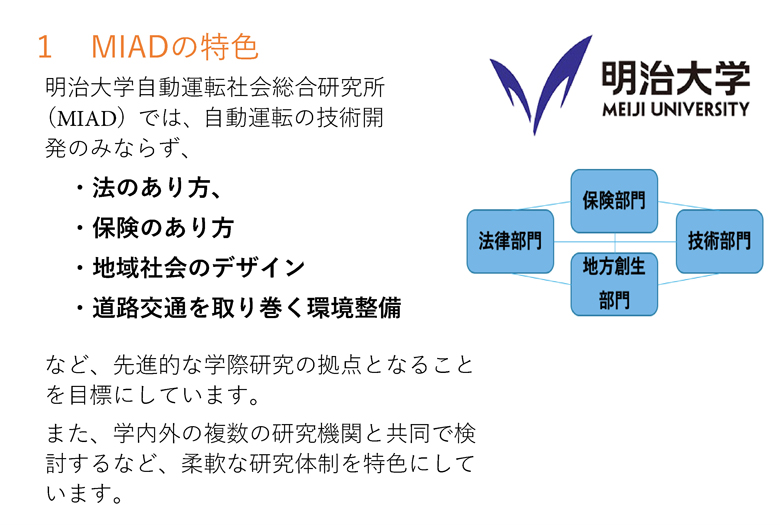 |
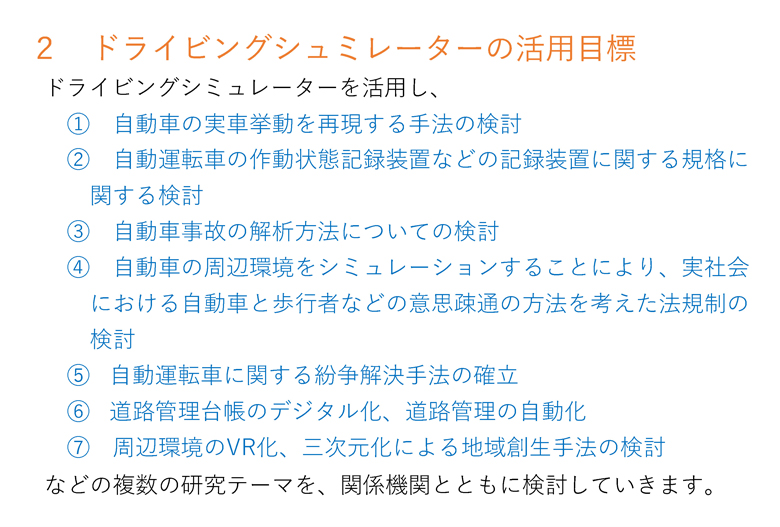 |
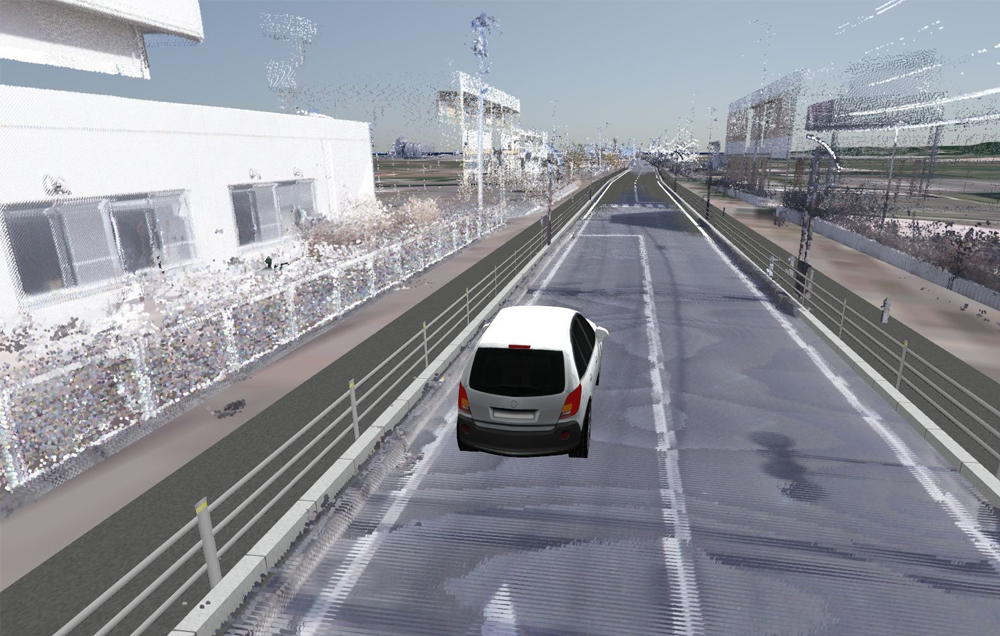 |
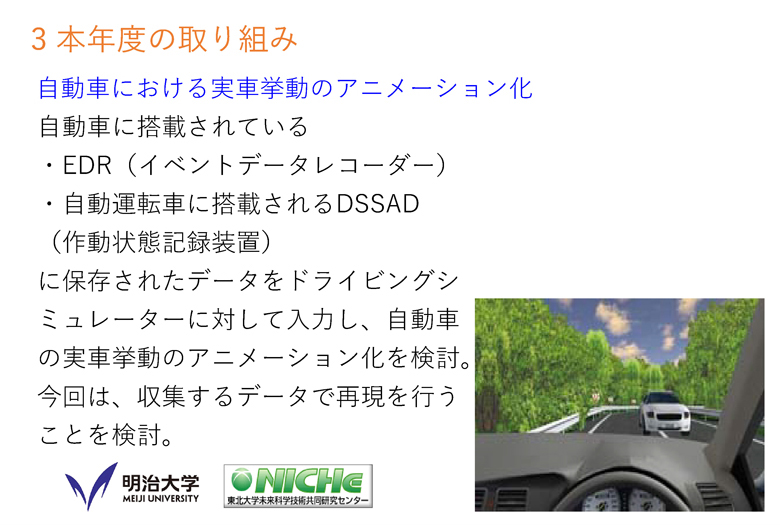 |
Visualizing the collected three-dimensional laser
point cloud using UC-win/Road |
New Possibilities Opened Up by Collaborative Research Beyond Humanities and Sciences
"It is a matter of course for those who study insurance to treat autonomous driving, but people may consider it strange, asking me why." In fact, in Japanese nonlife insurance market, the share that the car insurance including compulsory automobile liability insurance accounts for more than 50%. Those concerned with insurance are much interested in the issues like "What will become of liability when it comes to autonomous driving?" or "How the causes of traffic accidents should be analyzed?". Moreover, since calculation of the premium depends on data, the data to be gained by using DS is likely to be utilized not only for indemnity but also services beyond the conventional framework of "insurance" such as damage prevention, explains Prof. Nakabayashi.
"In addition, if it becomes possible to take various phenomena occurring in the actual world into the virtual world, and do various kinds of consideration including prediction, it will also be possible to react to diverse types of disasters and accidents quickly and logically. Then some issues to keep in mind can be assumed, such as treatment of personal data as well as a wide range of consensus building. In this sense, this attempt of MIAD is an important thing to tackle with in the center of the world in the future, isn't it?", says Prof. Suzuki, speaking of his own consciousness.
On the other hand, through these efforts, Lawyer Yoshida, who decided to adopt DS, says that it is his firm belief that if not a few research institutes and experts in many research fields are connected together and take part in interdisciplinary research rather than determining their research theme separatively based on their own specialty fields, new ideas and development can be expected. " I think that new knowledge will be created just by conducting various research together regardless of whether it is in the field of the humanities or the sciences."
|
